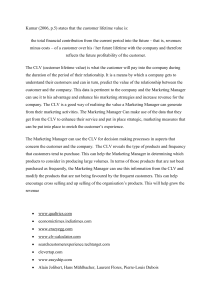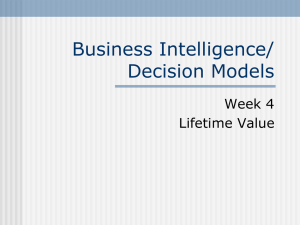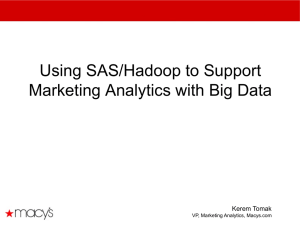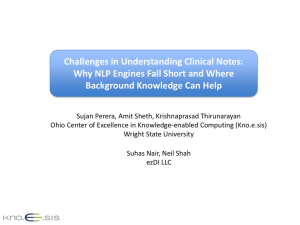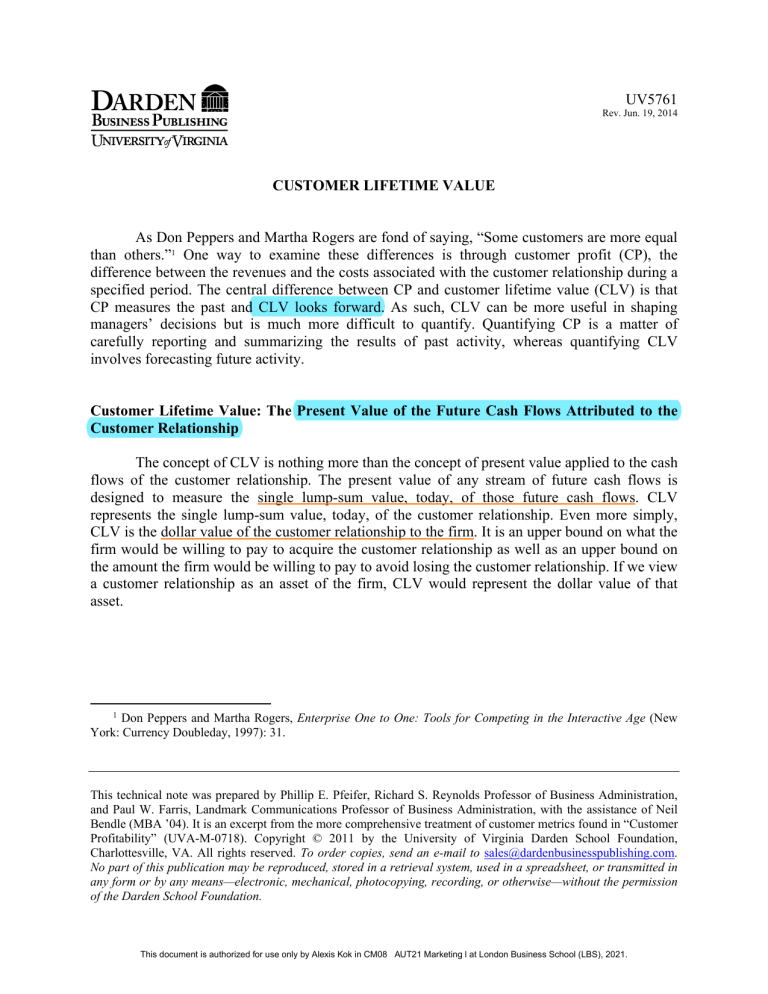
UV5761 Rev. Jun. 19, 2014 CUSTOMER LIFETIME VALUE As Don Peppers and Martha Rogers are fond of saying, “Some customers are more equal than others.”1 One way to examine these differences is through customer profit (CP), the difference between the revenues and the costs associated with the customer relationship during a specified period. The central difference between CP and customer lifetime value (CLV) is that CP measures the past and CLV looks forward. As such, CLV can be more useful in shaping managers’ decisions but is much more difficult to quantify. Quantifying CP is a matter of carefully reporting and summarizing the results of past activity, whereas quantifying CLV involves forecasting future activity. Customer Lifetime Value: The Present Value of the Future Cash Flows Attributed to the Customer Relationship The concept of CLV is nothing more than the concept of present value applied to the cash flows of the customer relationship. The present value of any stream of future cash flows is designed to measure the single lump-sum value, today, of those future cash flows. CLV represents the single lump-sum value, today, of the customer relationship. Even more simply, CLV is the dollar value of the customer relationship to the firm. It is an upper bound on what the firm would be willing to pay to acquire the customer relationship as well as an upper bound on the amount the firm would be willing to pay to avoid losing the customer relationship. If we view a customer relationship as an asset of the firm, CLV would represent the dollar value of that asset. 1 Don Peppers and Martha Rogers, Enterprise One to One: Tools for Competing in the Interactive Age (New York: Currency Doubleday, 1997): 31. This technical note was prepared by Phillip E. Pfeifer, Richard S. Reynolds Professor of Business Administration, and Paul W. Farris, Landmark Communications Professor of Business Administration, with the assistance of Neil Bendle (MBA ’04). It is an excerpt from the more comprehensive treatment of customer metrics found in “Customer Profitability” (UVA-M-0718). Copyright © 2011 by the University of Virginia Darden School Foundation, Charlottesville, VA. All rights reserved. To order copies, send an e-mail to sales@dardenbusinesspublishing.com. No part of this publication may be reproduced, stored in a retrieval system, used in a spreadsheet, or transmitted in any form or by any means—electronic, mechanical, photocopying, recording, or otherwise—without the permission of the Darden School Foundation. This document is authorized for use only by Alexis Kok in CM08 AUT21 Marketing l at London Business School (LBS), 2021. -2- UV5761 Cohort and incubate One way to project the value of future customer cash flows is to make the heroic assumption that the customers acquired several periods ago are no better or worse (in terms of their CLV) than the ones currently acquired. We then go back and collect data on a cohort of customers, all acquired at about the same time, and carefully reconstruct their cash flows over some finite number of periods. The next steps are to discount the cash flow for each customer back to the time of acquisition, to calculate the sample customers’ CLVs, and then to average all sample CLVs together to produce an estimate of the CLV of each newly acquired customer. This method is referred to as the “cohort and incubate” approach. Equivalently, one can calculate the present value of the total cash flow from the cohort and divide by the number of customers to get the average CLV for the cohort. If the value of customer relationships is stable across time, the average CLV of the cohort sample is an appropriate estimator of the CLV of newly acquired customers. As an example of this cohort-and-incubate approach, Berger, Weinberg, and Hanna (2003) followed all the customers acquired by a cruise-ship line in 1993. The 6,094 customers in the cohort of 1993 were tracked (incubated) for five years. The total net present value of the cash flows from these customers was $27,916,614. These flows included revenue from the cruises taken (the 6,094 customers took 8,660 cruises over the five-year horizon), variable cost of the cruises, and promotional costs. The total five-year net present value of the cohort expressed on a per-customer basis came out to be $27,916,614 ÷ 6,094, or $4,581 per customer. This is the average five-year CLV for the cohort. According to the report: Prior to this analysis, [cruise-line] management would never spend more than $3,314 to acquire a passenger…Now, aware of CLV (both the concept and the actual numerical results), an advertisement that [resulted in a cost per acquisition of $3,000 to $4,000] was welcomed—especially since the CLV numbers are conservative (again, as noted, the CLV does not include any residual business after five years).2 The cohort-and-incubate approach works well when customer relationships are stationary—changing slowly over time. When the value of relationships changes slowly, a company can use the value of incubated past relationships as predictive of the value of new relationships. In situations where the value of customer relationships changes more rapidly, firms often use a simple model to forecast the value of those relationships. A model just means some assumptions about how the customer relationship will unfold. If the model is simple enough, it 2 Paul D. Berger, Bruce Weinberg, and Richard C. Hanna, “Customer Lifetime Value Determination and Strategic Implications for a Cruise-Ship Company,” Journal of Database Marketing and Customer Strategy Management 11, no. 1 (2003): 49. This document is authorized for use only by Alexis Kok in CM08 AUT21 Marketing l at London Business School (LBS), 2021. -3- UV5761 may even be possible to find an equation for the present value of the model of future cash flows. This makes the calculation of CLV even easier as it now requires only the substitution of numbers for the situation into the equation for CLV. Next, we will explain what is perhaps the simplest model for future customer cash flows and the equation for the present value of those expected cash flows. Although not the only model of future customer cash flows, this one is used the most. Customer lifetime value model The CLV formula3 multiplies the per-period cash margin, $M, by a factor that represents the present value of the customer relationship’s expected length (Equation 1): CLV $M [ r ] 1 d r (1) where r is the per-period retention rate and d is the per-period discount rate. So, in the model, CLV is a multiple of $M, the per-period dollar margin (net of retention spending). The multiplicative factor represents the present value of the expected length (number of periods) of the customer relationship. When r = 0, the customer will never be retained and the multiplicative factor is zero. When r = 1, the customer is always retained and the firm receives $M in perpetuity. The present value of the $M in perpetuity turns out to be $M ÷ d. For retention values in between, the CLV formula tells us the appropriate multiplier. Example: An Internet service provider charges $19.95 per month. Variable costs are about $1.50 per account per month. With marketing spending of $6 per year, the company’s attrition is only 0.5% per month. At a monthly discount rate of 1%, what is the CLV of a customer? $M = ($19.95 − $1.50 – [$6 ÷ 12]) = $17.95 r = 0.995 d = 0.01 CLV = $M (r ÷ [1 + d − r]) CLV = $17.95 (0.995 ÷ [1 + 0.01 − 0.995]) CLV = ($17.95) (66.33) CLV = $1,191 3 Sunil Gupta and Donald R. Lehmann “Customers as Assets,” Journal of Interactive Marketing 17, no. 1 (2003): 9–24. This document is authorized for use only by Alexis Kok in CM08 AUT21 Marketing l at London Business School (LBS), 2021. -4- UV5761 Limitations of the CLV model The model for customer cash flows treats the firm’s customer relationships as something of a leaky bucket. In each period, a fraction (1 less the retention rate) of the firm’s customers leave and are lost for good. The CLV model has only three parameters: (1) constant margin (contribution after deducting variable costs including retention spending) per period; (2) constant retention probability per period; and (3) discount rate. Furthermore, the model assumes that in the event the customer is not retained, he or she is lost for good. Finally, the model assumes the first margin will be received (with probability equal to the retention rate) at the end of the first period. One other assumption of the model is that the firm uses an infinite horizon when it calculates the present value of future cash flows. Although no firm actually has an infinite horizon, the consequences of assuming one are discussed below. The retention rate—and by extension the attrition rate—are drivers of CLV. Very small changes can make a major difference to the lifetime value calculated. Accuracy in this parameter is vital to meaningful results. The retention rate is assumed to be constant across the life of the customer relationship. For products and services that go through a trial, conversion, and loyalty progression, retention rates will increase over the lifetime of the relationship. In those situations, the model given here might be too simple. If the firm wants to utilize a sequence of retention rates, a spreadsheet model can be used to calculate CLV. The contribution is assumed to be constant across time. If the margin is expected to increase or decrease with the duration of the customer relationship, the simple model will not apply. Take care not to use this CLV formula for relationships in which customer inactivity does not signal the end of the relationship. In catalogs, for example, a small percentage of the firm’s customers purchase from any given catalog. Don’t confuse the percentage of customers active in a given period (relevant for the cataloger) with the retention rates in this model. If customers often return to do business with the firm after a period of inactivity, the previous CLV formula does not apply. Also take care to match the period of the model to the period of the retention events. If retention happens monthly, for example, then use a monthly model. If retention happens every six months (as for auto insurance), then use a biannual model. If cash flows are spread out within the retention period, then use their present value in the CLV formula. This document is authorized for use only by Alexis Kok in CM08 AUT21 Marketing l at London Business School (LBS), 2021. -5- UV5761 The infinite horizon assumption In some industries and companies, it is typical to calculate four- or five-year customer values instead of using the infinite time horizon inherent in the previous formula. Of course, over shorter periods, customer retention rates are less likely to be affected by major shifts in technology or competitive strategies and are more likely to be captured by historical retention rates. For managers, the question is, “Does it make a difference whether I use the infinite time horizon or, for example, the five-year customer value?” The answer to this question is, “Yes, sometimes it can make a difference because the value over five years can be less than 70% of the value over an infinite horizon.” Table 1 calculates the percentages of (infinite-horizon) CLV accruing in the first five years. If retention rates are higher than 80% and discount rates are lower than 20%, differences in the two approaches will be substantial. Depending on the strategic risks that companies perceive, the additional complexities of using a finite horizon may be informative. Table 1. Five-year CLV as a percentage of infinite-horizon CLV. 1 40% Discount Rate 2% 4% 6% 8% 10% 12% 14% 16% 18% 20% 99% 99% 99% 99% 99% 99% 99% 100% 100% 100% Year 3 4 5 Retention Rate 50% 60% 70% 80% Percent of CLV Accruing 97% 93% 85% 70% 97% 94% 86% 73% 98% 94% 87% 76% 98% 95% 89% 78% 98% 95% 90% 80% 98% 96% 90% 81% 98% 96% 91% 83% 99% 96% 92% 84% 99% 97% 93% 86% 99% 97% 93% 87% 2 6 90% 47% 51% 56% 60% 63% 66% 69% 72% 74% 76% CLV with initial margin If you consult other sources on CLV, you may encounter a slightly different formula for CLV (Equation 2): CLValternative $M [ 1 d ] 1 d r (2) This alternative formula applies to a situation in which the initial cash flow is a certain $M received at the beginning of the first period. Because of this, this alternative formula always This document is authorized for use only by Alexis Kok in CM08 AUT21 Marketing l at London Business School (LBS), 2021. -6- UV5761 comes out to be $M higher than the original formula. It represents the value of the customer if and when acquired. Prospect Lifetime Value One of the major uses of CLV is to inform prospecting decisions. A prospect is someone the firm will spend money on in an attempt to acquire him or her as a customer. The acquisition spending must be compared not just with the contribution from the immediate sales it generates, but also with the future cash flows expected from the newly acquired customer relationship (the CLV). Only with a full accounting of the value of the newly acquired customer relationship will the firm be able to make informed economic-prospecting decisions. The expected prospect lifetime value (PLV) will be the value expected from each prospect minus the cost of prospecting. The value expected from each prospect will be a—the expected fraction of prospects who will make a purchase and become customers—times ($M0 + CLV), where $M0 is the average margin the firm makes on the initial purchases net of any marketing spending used to attempt to retain the customer at the end of the first period. The cost will be $A, the amount of acquisition spending per prospect. The formula for expected PLV is shown in Equation 3: PLV a($M 0 CLV ) $ A (3) If PLV is positive, the acquisition spending is a wise investment. If PLV is negative, the acquisition spending should not be made. The PLV number will usually be very small. While CLV is sometimes in the hundreds of dollars, PLV can come out to be only a few pennies. Just remember that PLV applies to prospects, not customers. A large number of small- but positive-value prospects can add to a considerable amount of value for a firm. Example: A service company plans to spend $60,000 on an advertisement reaching 75,000 readers. If the service company expects the advertisement to convince 1.2% of the readers to take advantage of a special introductory offer (priced so low that the firm makes a $10 margin on this initial purchase) and the CLV of the acquired customers is $100, is the advertisement economically attractive? Here, $A is $0.80, a is 0.012, and $M0 is $10. The PLV of each of the 75,000 prospects is PLV a($M 0 CLV ) $ A = 0.012 × ($10 + $100) − $0.80 = $0.52 This document is authorized for use only by Alexis Kok in CM08 AUT21 Marketing l at London Business School (LBS), 2021. (4) -7- UV5761 The expected lifetime value of a prospect is $0.52. The total expected value of the prospecting effort will be 75,000 × $0.52 = $39,000. The proposed acquisition spending is economically attractive. If we are uncertain about the 0.012 acquisition rate, we might ask what the response rate from the prospecting campaign must be in order for it to be economically successful. We can get that number using Excel’s Goal Seek function to find the a value that sets PLV to zero. Or we can use a little algebra and substitute $0 in for PLV and solve for a: $A $ M 0 CLV = $0.80 ÷ ($10+$100) = 0.007273. abe (5) The acquisition rate must exceed 0.7273% for the campaign to break even on an NPV basis. Issues with PLV Perhaps the biggest challenge in calculating PLV is estimating the CLV. The other terms (acquisition spending, expected acquisition rates, and initial margin) all refer to flows or outcomes in the near future, whereas CLV requires longer-term projections. Another caution worth mentioning is the decision to spend money on customer acquisition whenever PLV is positive. This rests on an assumption that the customers acquired would not have been acquired had the firm not spent the money. In other words, this approach gives the acquisition spending “full credit” for the subsequent customers acquired. If the firm has several simultaneous acquisition efforts, for example, dropping one of them might lead to increased acquisition rates for the others. Situations such as these (where one solicitation cannibalizes another) require a more complicated analysis. The firm must be careful to search for the most economical way of acquiring new customers. If there are alternative prospecting approaches, the firm must be careful not to simply go with the first one that gives a positive projected PLV. Given a limited number of prospects, the approach that gives the highest expected PLV should be used. Finally, we want to warn you that there are other ways to perform the calculations necessary to judge the economic viability of a given prospecting effort. Although these other approaches are equivalent to the one presented here, they differ with respect to what is included in CLV. Some approaches will include the initial margin as part of CLV. For our service company example, this approach would say that the CLV is $110. This document is authorized for use only by Alexis Kok in CM08 AUT21 Marketing l at London Business School (LBS), 2021. -8- UV5761 Another common approach includes both the initial margin and the expected acquisition cost per acquired customer as part of the CLV. For the service company example, this CLV equals $110 – ($60,000 ÷ 900) = $43.33. Here, 900 is the expected number of new customers and $60,000 ÷ 900 is the expected cost per new customer. The $43.33 is the expected value of the prospecting effort expressed on a per-customer-acquired basis. If this CLV is positive, the prospecting effort is economically attractive. Notice that $43.33 times the 900 expected new customers equals $39,000, the same total net value from the campaign calculated in the original example. The two ways to do the calculations are equivalent. Retention and Customer Lifetime Value Reichheld and Sasser (1990)4 helped popularize the idea that customer retention is an important driver of firm financial success. They reported that “reducing defections by 5% boosts profits 25% to 85%.”5 Rather than rely on the Reichheld and Sasser percentages, we offer three approaches for quantifying the economic benefits of increased retention for a given firm.6 In the first approach, the firm might build an electronic spreadsheet model to forecast future company profits and cash flows as a function of a retention rate or schedule of retention rates. One could then change the retention rate or schedule of retention rates and observe what happens to profits and cash flows. These “what-if” analyses conducted using a spreadsheet model would be one way to quantify the benefits of increased retention. If the firm thought, for example, that increased retention would reduce the need for future acquisition spending, that linkage could be built into the model and captured in the what-if analyses. The second and third approaches ask how increased retention affects the lifetime value of the customer. Whereas the firm-level spreadsheet approach above projects the future stream of company profits and cash flows, CLV accounts for the dollar value of the future cash flows attributed to the customer—either a single customer or (more than likely) an average customer. In the second approach, the firm might build an electronic spreadsheet model of future cash flows associated with the customer relationship. That model might allow for margins and retention rates to increase with customer tenure. The present value of the projected future cash flows would be the estimated CLV. To quantify the economic benefits of increased retention, once again the firm could conduct what-if sensitivities using the model of customer cash flows. 4 Frederick F. Reichheld and W. Earl Sasser Jr., “Zero Defections: Quality Comes to Services,” Harvard Business Review (September–October 1990): 105–11. 5 Reichheld and Sasser Jr. 6 Phillip E. Pfeifer and Paul W. Farris, “The Elasticity of Customer Value to Retention: The Duration of a Customer Relationship,” Journal of Interactive Marketing 18, no. 2 (Spring 2004): 20–31. This document is authorized for use only by Alexis Kok in CM08 AUT21 Marketing l at London Business School (LBS), 2021. -9- UV5761 For example, one might multiply the schedule of retention rates by 1.01 and recalculate the CLV. The resulting number would represent the CLV if all retention rates increased by 1%. In the third approach, the firm might assume constant margins and retention rates and perform what-if analyses directly on the formula for CLV presented earlier in this note. Example: Consider again the customer relationship where $M = $17.95, d = 0.01, and r = 0.995. The calculated CLV was $1,191. Now suppose the firm expected r to increase to 0.996 as a result of several recent customer-relationship-management initiatives. To quantify the benefits of the expected increased retention, we calculate CLV for r = 0.996 and get CLV = $1,277 (an increase of about 7.2%). When using the CLV formula, remember the timing assumptions inherent in this formula. The formula applies to current customers whose next cash flow occurs in one period in the event they are retained. This timing assumption is conservative because, in actuality, the firm’s current customers will be spread throughout the renewal cycle. For some customers, the renewal event will be imminent, not a full period away. The change in CLV for a change in retention rate is a measure of the increase in dollar value of the firm’s current customer base. This dollar value does not translate directly to an equivalent increase in yearly profits because there are many other factors affecting firm profits. If the firm wants to measure the impact of increased retention rate on yearly profits, a firm-level model described in the first approach is required. The firm should also remember that increases in retention rate not only affect the value of the firm’s current customers, but also the value of the firm’s current prospects whenever the increases in retention rate are expected to also apply to customers the firm will acquire in the future. The economic benefits of increased retention must be compared with the costs required to achieve the increased retention rates in order to make a sound investment decision. Conclusion CLV provides firms with a forward-looking metric that combines customers’ retention rate, marketing spend, and cash flows. The metric is a good tool to assess the effects of increasing retention rates on future customer value and the amount a firm should spend on customer acquisition. When marketing spend is connected to retention rates and future cash flows, the metric provides a mechanism for firms to optimize marketing spending. This document is authorized for use only by Alexis Kok in CM08 AUT21 Marketing l at London Business School (LBS), 2021.
